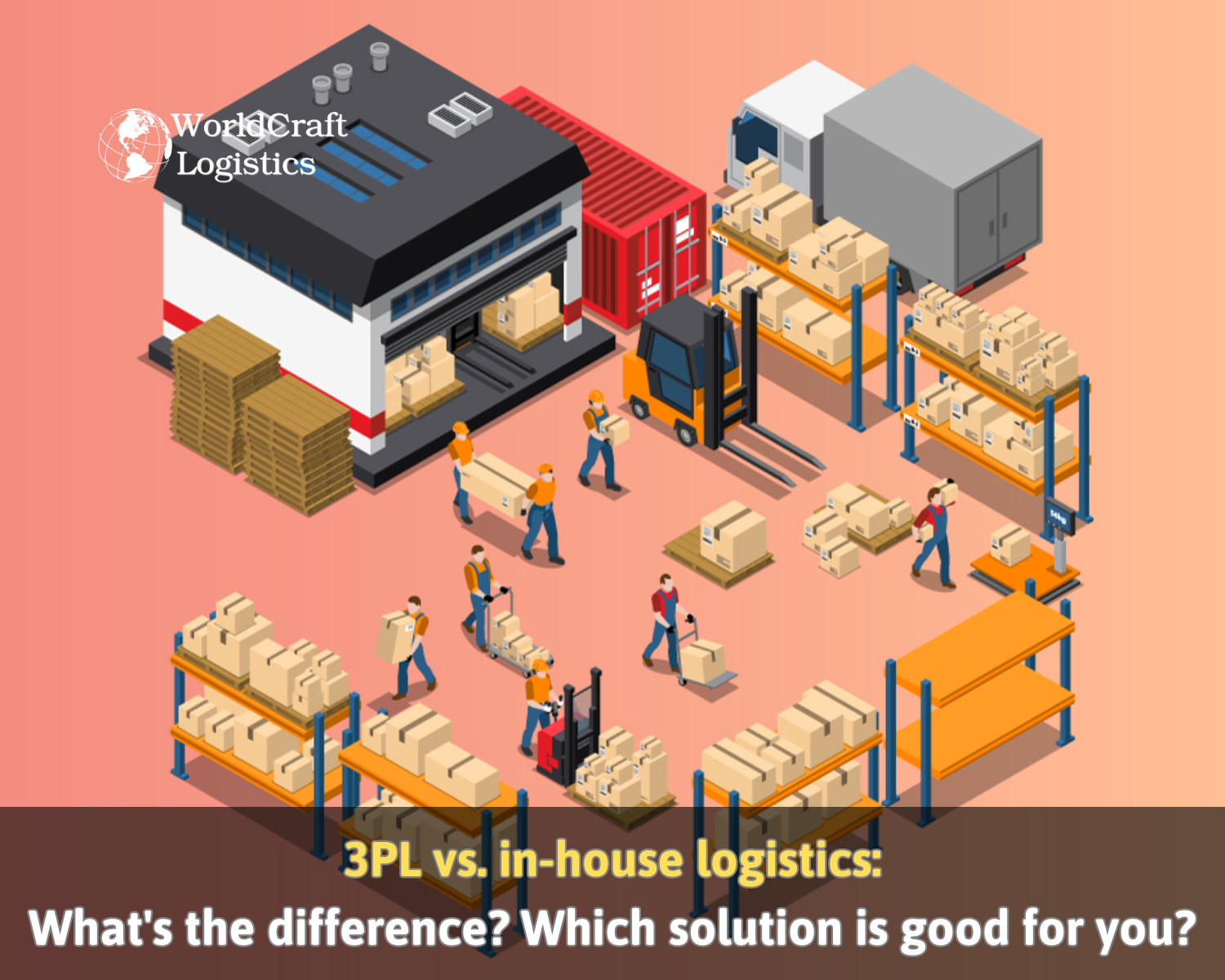Picture a bustling hub of logistics, where products flow seamlessly from one truck to another, with no pit stops for storage. This is the world of cross docking, a dynamic and efficient approach to supply chain management. In this exploration of What Is cross docking, we delve into the intricacies of this strategy that has revolutionized the way goods move from manufacturer to consumer. Join with Worldcraft Logistics as we unravel the mysteries of this high-velocity logistics process and uncover the benefits it brings to industries around the global.
1. What Is Cross-Docking?

Cross-docking is a logistics strategy designed to expedite the delivery of goods and enhance overall supply chain efficiency. It entails the swift unloading of products from incoming shipment vehicles at a logistics facility, followed by their immediate transfer to outbound shipment vehicles, with minimal to no interim storage. This approach allows companies to consolidate items from various suppliers, break down bulk shipments into smaller lots, and reconfigure products for efficient distribution to retail outlets, fulfillment centers, and end customers. Successful docking warehouse necessitates close coordination among a company's supply chain partners, including suppliers and freight carriers. The benefits are manifold: quicker product delivery, reduced reliance on warehouse space, improved inventory management, and lowered transportation and labor expenses...
As you expand your knowledge in logistics and supply chain management to enhance your business operations, here are some relevant articles that are sure to pique your interest:
- Awaiting Fulfillment Meaning & Why Is It Important in Ecommerce?
- Deciphering FCL and LCL: Choosing the Right Shipping Method
2. Limitations and benefits of cross-docking
2.1 Benefits of cross-docking

Cross-docking offers a multitude of advantages that can transform the way businesses manage their supply chains, particularly in the realm of e-commerce. Here's a closer look at the benefits of cross-docking:
- Faster Shipping & Receiving Times: Cross-docking paves the way for lightning-fast order fulfillment. By reducing or eliminating the need for product storage, items swiftly find their way to their final destinations. Moreover, it enhances shipping efficiency by breaking down larger shipments into smaller, more manageable loads, all traveling in the same direction. On the receiving end, complexity is minimized since it merely involves accounting for incoming and outgoing inventory, rather than the intricate scanning and tracking within a traditional warehouse management system (WMS).
- Reduced Costs and Time Savings: Cross-docking spells cost savings across the board. Businesses can significantly cut their Cost of Goods Sold (COGS), encompassing expenses related to product purchase, first-mile and last-mile shipping, and inventory carrying costs. This approach eliminates the need for extensive e-commerce warehousing, promoting cost-effective delivery directly to customers. It also streamlines inventory management, facilitating just-in-time replenishment. Additionally, bulk inventory tracking minimizes labor requirements and saves precious time, creating an efficient inventory storage system.
- Centralized Product Handling: The heart of cross-docking lies in its central hubs, or cross-dock warehouses. These locations serve as distribution centers and sorting facilities, optimizing the supply chain. Products are sorted and dispatched to multiple carriers based on their destination, promoting efficient last-mile delivery. This centralized approach is particularly beneficial for B2B fulfillment, where single-item storage and picking are not required.
- Reduced Material Handling: Cross-docking operations entail significantly less material handling. There's a reduced need to track the movement of goods, provide storage, and manage multiple SKUs. This streamlined process allows for a high inventory turnover rate. Moreover, it benefits items that require minimal handling throughout the supply chain, such as perishable goods like food and beverages, products with shorter shelf lives (e.g., makeup, pharmaceuticals, vitamins, and supplements), and high-quality items less prone to damage from temporary storage.
In essence, cross-docking revolutionizes supply chain efficiency, offering a faster, cost-effective, and streamlined approach to delivering products to their intended destinations.
2.2 Limitations of cross-docking

In spite of the numerous advantages associated with cross-docking, it is essential to acknowledge the potential drawbacks that companies may encounter when adopting this strategy. While these drawbacks are not insurmountable, they require careful consideration:
- Requires Close Coordination: Successful cross-docking hinges on seamless coordination between warehouse and transportation teams. Products are promptly sorted and shipped directly from inbound trucks, bypassing warehouse storage. Inadequate coordination can result in shipping errors and delays.
- Requires Real-Time Visibility: Cross-docking demands real-time visibility into inventory levels. Immediate action is taken upon the arrival of products, and any delays in receiving shipment information can lead to process errors.
- May Not Be Suitable for All Products: Cross-docking may not suit all product types, especially those with high value or special handling requirements.
- Can Be Labor Intensive: The labor-intensive nature of cross-docking, involving rapid sorting and loading onto outbound trucks, can pose challenges if staffing levels are insufficient to manage the volume of inbound and outbound shipments.
- Can Be Challenging for Small Companies: Smaller companies may find cross-docking challenging due to the need for close coordination and real-time visibility, which can be challenging to achieve without the appropriate technology or adequate staff.
Despite these potential challenges, it's important to emphasize that cross-docking can offer substantial benefits when implemented correctly. It has the potential to reduce shipping times, cut costs, and enhance customer service.
If you are contemplating the adoption of cross-docking in your warehouse operation, it's advisable to carefully evaluate the pros and cons. While cross-docking can be a valuable solution for many companies, it may not be suitable for every operation.
3. Types of cross-docking
Cross-docking is a versatile logistics strategy, and it can be categorized into several types based on its operational approach. Understanding these types can help businesses choose the most suitable cross-docking method for their specific needs:
3.1 Continuous Cross-Docking

Continuous cross-docking, often referred to as "flow-through cross-docking," involves the direct transfer of products from inbound trucks to outbound trucks with minimal or no storage time in between. This method is ideal for goods with a consistent and predictable demand, such as fast-moving consumer goods (FMCG) and perishable items. It helps to maintain the flow of products through the supply chain without the need for warehousing, reducing handling and storage costs.
3.2 Consolidation Arrangements

Consolidation cross-docking focuses on merging smaller shipments into larger ones. In this approach, multiple smaller shipments from different suppliers are received at a cross-docking facility and combined into a single, larger outbound shipment. This method is often used to optimize transportation efficiency, reduce shipping costs, and enhance delivery schedules. It's particularly beneficial for businesses that receive goods from various sources and want to streamline their distribution process.
3.3 De-Consolidation Arrangements

De-consolidation cross-docking, sometimes referred to as "break bulk" cross-docking, involves the opposite process of consolidation. Incoming shipments with larger quantities are broken down into smaller shipments or individual orders for distribution. This method is commonly used in retail and e-commerce settings, where products need to be sorted and prepared for individual customers or store locations. De-consolidation cross-docking helps ensure that the right products reach the right destinations efficiently.
These three types of cross-docking offer businesses the flexibility to adapt their supply chain operations to various product characteristics and distribution requirements. Choosing the most suitable type of cross-docking can lead to significant improvements in logistics efficiency and cost savings.
4. When businesses choose Cross-Docking?

Cross-docking proves highly effective for tailored business requirements and specific product categories. For instance, companies dealing in time-sensitive, high-volume goods leverage cross-docking to swiftly deliver merchandise to stores. E-commerce providers strategically employ cross-docking to gain a competitive edge by ensuring rapid customer shipments. Here are instances where cross-docking is an ideal match:
- Perishable Goods: When delivering fresh food and agricultural products, speed is paramount. Rapid transportation minimizes the time available for stores to sell these goods before they expire.
- Seasonal or Promotional Merchandise: Merchandise tied to seasons or promotional events must reach stores swiftly, as demand is time-limited.
- High-Volume Products with Consistent Demand: Steady demand allows companies to accurately forecast product volumes moving through cross-docking facilities. This enables efficient coordination with suppliers and ensures ample carrier capacity for continuous product flow. Many major retailers rely on cross-docking to replenish staple high-volume products at their outlets.
- Items Requiring No Inspection: Products that don't necessitate inbound inspection for compliance with industry standards can transition directly from incoming to outgoing carriers.
- Products with Specialized Environmental Needs: Certain items, such as specific medications, demand precise temperature control during transport. Cross-docking eliminates the need for costly, temperature-controlled warehouse space at distribution centers, as these products can be directly transferred between incoming and outgoing trucks.
In understanding these examples, we unravel the versatility and advantages of cross-docking as a strategic logistical solution.
5. Pre-Distribution vs. Post-Distribution Cross-Docking

Cross-docking encompasses two fundamental types: Pre-Distribution and Post-Distribution. In the Pre-Distribution approach, goods undergo unloading, sorting, and repacking according to predefined distribution instructions. Essentially, the customer is identified before the goods depart from the supplier's location.
Conversely, the Post-Distribution process defers sorting until the appropriate facility and customers are selected based on demand. Consequently, products spend a bit more time within the distribution or cross-docking facility. Nonetheless, this extra time proves advantageous for retailers and suppliers as it allows them to make more informed and strategic decisions about shipping destinations. These decisions are based on factors such as in-store inventory levels, sales forecasts, and point-of-sale trends, ultimately enhancing overall efficiency.
6. The Difference Between Cross-Docking and Warehousing
The key distinction between cross-docking and warehousing lies in the duration of product storage within a logistics facility. In conventional warehousing, merchandise undergoes receipt, unpacking, and prolonged storage, often spanning days, weeks, or even months before eventual shipment to customers. Conversely, cross-docking operates on a different premise. Here, goods undergo reception, sorting, and immediate transference to outbound trucks for prompt delivery, without protracted storage.
7. Cross docking services GOOD in the U.S - Worldcraft Logistics company

Cross-docking service in the U.S. are known for their effectiveness and efficiency. They play a crucial role in the logistics and supply chain industry by facilitating the rapid movement of goods from suppliers to consumers or retailers. These services of Worldcraft Logistics LLC. are highly regarded for several reasons:
- Speed and Timeliness to reducing the time goods spend in transit and minimizing delays in reaching their final destinations.
- Cost Efficiency for businesses aiming to improve their bottom line.
- Cross-docking helps in managing inventory more effectively by reducing the need for extensive warehousing, control over stock levels and reduce carrying costs...
Overall, cross-docking service in the U.S of Worldcraft Logistics company are valued for their ability to enhance the speed, efficiency, and cost-effectiveness of logistics operations, making them a valuable asset for businesses seeking to streamline their supply chains.
8. Cross-Docking FAQs
8.1 Is cross-docking only used in the transportation of goods?
While cross-docking is commonly associated with transportation, it's also used in retail distribution centers to sort and consolidate products before they reach store shelves.
8.2 Can cross-docking reduce shipping costs?
Yes, cross-docking can reduce shipping costs by eliminating the need for long-term storage and reducing the handling of goods. It can also lead to shorter transit times.
8.3 What technology is used in cross-docking operations?
Cross-docking often relies on barcode scanning, RFID technology, and transportation management systems (TMS) to track and manage the flow of goods efficiently.
In conclusion, Worldcraft Logistics commented that cross docking is a dynamic and efficient logistics strategy that has transformed the way goods move through supply chains. As industries continue to evolve, cross-docking will likely remain a key element in ensuring the swift and cost-effective delivery of goods to consumers and retailers alike, contributing to the ongoing success of supply chain management.





